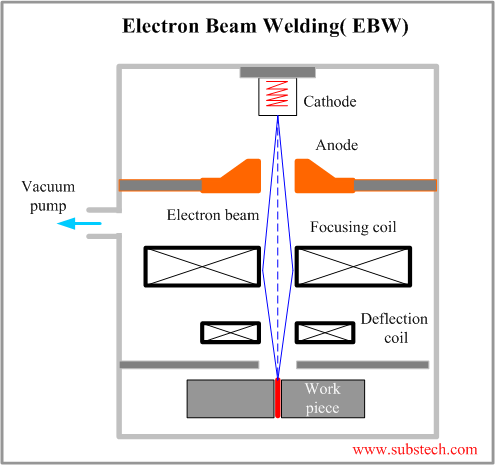Main page
About us
Sliding Bearings Consulting
Advertising Opportunities

to Metals
to Metal joining technologies (welding, brazing, soldering)
Electron Beam Welding (EBW)
Dr. Dmitri Kopeliovich
Electron Beam Welding is a welding process utilizing a heat generated by a beam of high energy electrons. The electrons strike the work piece and their kinetic energy converts into thermal energy heating the metal so that the edges of work piece are fused and joined together forming a weld after Solidification.
The process is carried out in a vacuum chamber at a pressure of about 2*10-7 to 2*10-6 psi (0.00013 to 0.0013 Pa). Such high vacuum is required in order to prevent loss of the electrons energy in collisions with air molecules.
The electrons are emitted by a cathode (electron gun). Due to a high voltage (about 150 kV) applied between the cathode and the anode the electrons are accelerated up to 30% - 60% of the speed of light. Kinetic energy of the electrons becomes sufficient for melting the targeted weld. Some of the electrons energy transforms into X-ray irradiation.
Electrons accelerated by electric field are then focused into a thin beam in the focusing coil. Deflection coil moves the electron beam along the weld.
Electron Beam is capable to weld work pieces with thickness from 0.0004” (0.01 mm) up to 6” (150 mm) of steel and up to 20” (500 mm) of aluminum. Electron Beam Welding may be used for joining any metals including metals, which are hardly weldable by other welding methods: refractory metals (tungsten, molybdenum, niobium) and chemically active metals (titanium, zirconium, beryllium). Electron Beam Welding is also able to join dissimilar metals.

Advantages of Electron Beam Welding (EBW):
- Tight continuous weld;
- Low distortion;
- Narrow weld and narrow heat affected zone;
- Filler metal is not required.
Disadvantages of Electron Beam Welding (EBW):
- Expensive equipment;
- High production expenses;
- X-ray irradiation.
Related internal links


